
What is Brewsterite? Brewsterite is a rare mineral belonging to the zeolite group, known for its unique crystal structure and fascinating properties. Named after Sir David Brewster, a Scottish physicist, this mineral typically forms in volcanic rocks and hydrothermal environments. Brewsterite crystals often appear in colors ranging from white to pale yellow, sometimes even greenish. They are prized by collectors for their intricate, needle-like formations. But what makes Brewsterite truly special? Its ability to act as a natural filter, absorbing and trapping various substances, makes it valuable in industrial applications. Whether you're a geology enthusiast or just curious about minerals, Brewsterite offers a glimpse into the Earth's hidden treasures.
Key Takeaways:
- Brewsterite, a zeolite mineral, was discovered by Sir David Brewster in 1822. It's found in volcanic rocks, used in water purification, and can fluoresce under ultraviolet light.
- With its ion-exchange properties, Brewsterite has practical uses in water purification, gas separation, and environmental remediation. It's also a sought-after addition to mineral collections for its aesthetic appeal.
What is Brewsterite?
Brewsterite is a fascinating mineral that belongs to the zeolite group. Named after Sir David Brewster, this mineral has unique properties and interesting characteristics that make it a subject of study for geologists and mineral enthusiasts alike. Let's dive into some intriguing facts about Brewsterite.
Origins and Discovery
Understanding where Brewsterite comes from and how it was discovered can provide insight into its significance.
- Brewsterite was first discovered in 1822 by Sir David Brewster, a Scottish physicist and mineralogist.
- The mineral was named in honor of Brewster for his contributions to the field of mineralogy.
- Brewsterite is typically found in basaltic volcanic rocks, often in cavities and fissures.
- Significant deposits of Brewsterite have been located in Scotland, Ireland, and the United States.
- It is commonly associated with other zeolite minerals like stilbite, heulandite, and chabazite.
Physical Properties
Brewsterite's physical characteristics make it easily identifiable and distinguishable from other minerals.
- Brewsterite crystals are typically prismatic and can form in clusters or as individual crystals.
- The mineral has a vitreous to pearly luster, giving it a shiny appearance.
- Brewsterite's color ranges from colorless to white, with some specimens exhibiting shades of yellow, pink, or brown.
- It has a Mohs hardness of 4 to 4.5, making it relatively soft compared to other minerals.
- Brewsterite has a specific gravity of 2.1 to 2.2, which is considered light for a mineral.
Chemical Composition
The chemical makeup of Brewsterite is what gives it its unique properties.
- Brewsterite is a hydrated calcium, strontium, and barium aluminosilicate.
- Its chemical formula can be represented as (Ca, Sr, Ba)Al2Si6O16·5H2O.
- The mineral's composition can vary, with calcium, strontium, and barium substituting for one another.
- Brewsterite belongs to the zeolite group, known for their ability to exchange ions and absorb water.
- The mineral's structure consists of a framework of aluminosilicate tetrahedra, creating channels and cavities.
Formation and Environment
The conditions under which Brewsterite forms are quite specific and interesting.
- Brewsterite forms in low-temperature hydrothermal environments.
- It often crystallizes from volcanic gases or hydrothermal fluids in basaltic rocks.
- The mineral can also form in sedimentary rocks, particularly in tuffaceous sediments.
- Brewsterite is commonly found in geodes, which are hollow, rounded rocks lined with crystals.
- The presence of Brewsterite can indicate past volcanic activity and hydrothermal processes.
Uses and Applications
While Brewsterite may not be as well-known as other minerals, it has some practical uses.
- Brewsterite is used in water purification systems due to its ion-exchange properties.
- The mineral can remove heavy metals and other contaminants from water.
- Brewsterite is also used in gas separation processes, particularly for natural gas purification.
- Its ability to absorb water makes it useful as a desiccant in various industrial applications.
- Brewsterite is sometimes used as a soil conditioner to improve soil structure and fertility.
Collecting and Specimens
For mineral collectors, Brewsterite is a prized addition to any collection.
- Brewsterite specimens are often sought after for their aesthetic appeal and crystal formations.
- The mineral is typically collected from basalt quarries and volcanic regions.
- High-quality Brewsterite crystals can fetch high prices among collectors.
- Specimens with well-formed, transparent crystals are particularly valuable.
- Brewsterite is often displayed in museums and mineral exhibitions around the world.
Interesting Facts
Here are some additional tidbits about Brewsterite that you might find intriguing.
- Brewsterite can fluoresce under ultraviolet light, exhibiting a bright yellow or green glow.
- The mineral's name is sometimes misspelled as "Brewsterite" instead of "Brewsterite."
- Brewsterite crystals can grow up to several centimeters in length, though most are smaller.
- The mineral is often found in association with other zeolites, creating beautiful mineral assemblages.
- Brewsterite's ion-exchange properties make it useful in environmental remediation efforts.
Scientific Studies
Brewsterite has been the subject of various scientific studies due to its unique properties.
- Researchers have studied Brewsterite's ion-exchange capabilities for potential use in nuclear waste management.
- The mineral's structure has been analyzed using X-ray diffraction and electron microscopy.
- Studies have shown that Brewsterite can selectively remove certain ions from solutions, making it useful in chemical processes.
- Brewsterite's thermal stability has been investigated for potential applications in high-temperature environments.
- Ongoing research continues to explore new uses and applications for this versatile mineral.
Brewsterite: A Fascinating Mineral
Brewsterite, a rare and intriguing mineral, captivates enthusiasts and geologists alike. Found in volcanic rocks, this mineral boasts a unique crystal structure and a fascinating history. Named after Sir David Brewster, it’s a testament to the wonders of natural formations.
Its rarity makes it a prized specimen for collectors. Brewsterite's unique properties, like its ability to form in hydrothermal environments, add to its allure. Whether you're a seasoned geologist or a curious learner, understanding Brewsterite offers a glimpse into the Earth's geological processes.
From its discovery to its unique characteristics, Brewsterite remains a subject of fascination. So next time you come across this mineral, you'll appreciate the rich history and science behind it. Keep exploring the world of minerals; there's always something new to learn.
Frequently Asked Questions
Was this page helpful?
Our commitment to delivering trustworthy and engaging content is at the heart of what we do. Each fact on our site is contributed by real users like you, bringing a wealth of diverse insights and information. To ensure the highest standards of accuracy and reliability, our dedicated editors meticulously review each submission. This process guarantees that the facts we share are not only fascinating but also credible. Trust in our commitment to quality and authenticity as you explore and learn with us.


